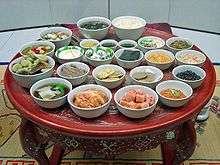Jangajji
| Jangajji | |
 Maneul jangajji, pickled garlic in a sauce made with soy sauce and vinegar. | |
| Korean name | |
|---|---|
| Hangul | 장아찌 |
| Hanja | none |
| Revised Romanization | jangajji |
| McCune–Reischauer | changatchi |
Jangajji or jangachi (Korean pronunciation: [tɕaŋaːtɕ͈i]) is a type of pickle in Korean cuisine which is made by pickling or marinating vegetables in a sauce for a long period of time. The dish is also sometimes called janghwa (장화). It was historically made during the harvest season and was eaten as a banchan (small side dish) when vegetables were scarce during winter. Whenever eating jangajji, it is cut into thin slices, seasoned with sesame oil, sugar, salt and sesame seeds.[1][2]
Ingredients
The food varies according to region and temperature. The main ingredients are varied, and may include garlic, daikon, cucumber, chili pepper leaves, Oriental muskmelon, perilla leaves, deodeok (Codonopsis lanceolata), among others. Generally, jangajji is pickled in ganjang (Korean soy sauce), gochujang (chili pepper paste), doenjang (soybean paste), or diluted vinegar. To make jangajji, vegetables should be either dried or salted to prevent the addition of surplus moisture to the condiment. In recent days, food preferences have changed and fresh vegetables are easily accessible, so consumption of jangajji has decreased significantly.[1][2]
Gallery
 Kkatnip jangakjji (깻잎장아찌), pickled perilla leaves
Kkatnip jangakjji (깻잎장아찌), pickled perilla leaves Doenjang gochu jangajji, chili pepper marinated in doenjang (soybean paste)
Doenjang gochu jangajji, chili pepper marinated in doenjang (soybean paste) Maneuljong jangajji, made with garlic stems marinated in gochujang
Maneuljong jangajji, made with garlic stems marinated in gochujang Jangajji and namul (wild vegetables) sold at Namdaemun Market in Seoul.
Jangajji and namul (wild vegetables) sold at Namdaemun Market in Seoul.
See also
References
- 1 2 "Kinds of Korean Ffood". Korea Agro-Fisheries Trade Corporation. Archived from the original on 2009-04-14.
- 1 2 장아찌 (in Korean). Empas / Britannica.
External links
| Wikimedia Commons has media related to Jangajji. |
 |
| This article is part of a series on |
| Korean cuisine 한국 요리 조선 료리 |
|---|
|
Staples |
|
|